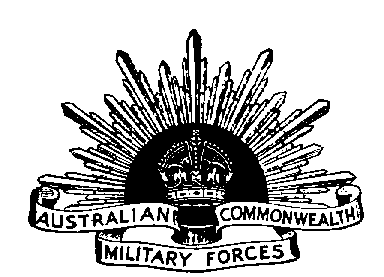

Frederic Godfrey Hughes was born in Windsor, Melbourne on 26 January 1858, the son of a grazier. He was educated at Melbourne Grammar and became a clerk for a land valuer. Later he set up his own land valuation business around 1884.
Hughes became involved in local politics and in 1898 Hughes was elected a St Kilda City Councillor. He served for 24 years and was Mayor of St Kilda from 1901 to 1902 and again from 1911 to 1912. He had various business interests, including directorships of Dunlop Rubber and South Broken Hill.Hughes joined the St Kilda Artillery Battery as a driver in 1875. He became a sergeant in 1883 and was commissioned in 1885. On 20 August 1888 he was promoted to captain and took command of the Victorian Nordenfeldt Battery, the Nordenfeldt being a kind of early machine gun. The next year the battery was absorbed into the Victorian Horse Artillery. Hughes was promoted to major in 1891. His battery was disbanded on 30 June 1897 and Hughes was transferred to the field artillery and became at staff officer at Headquarters in Melbourne. He was promoted to lieutenant colonel in 1900. In 1903, he was given command of the 11th Light Horse Regiment. On 6 December 1907 he was promoted to colonel and took command of the 4th Light Horse Brigade, which was renamed the 7th Light Horse Brigade in 1912. In 1909, Hughes became an aide de camp to the Governor General.
Hughes was appointed to the AIF as a colonel on 17 October 1914 and given command of the 3rd Light Horse Brigade, although he was probably too old. Like most militia brigadiers, Hughes was given a regular officer as a brigade major, in his case, Lieutenant Colonel J. M. Antill. Although not an easy man to get along with, Hughes relied heavily on "Bullant". His relationship with Lieutenant Colonel Noel Brazier of the 10th Light Horse Regiment was far more strained.
The brigade departed for Egypt in February 1915 where it trained until alerted for dismounted action at Gallipoli in May. It arrived on 20 May 1915 and became part of Major General A. J. Godley's New Zealand and Australian Division. The ANZAC commander, Lieutenant General W. R. Birdwood, had grave doubts about Hughes' capacity, but was averse to removing subordinates outright. Furthermore, he knew that Hughes had Antill to back him up and so decided to commit the 3rd Light Horse Brigade to the line, relieving the New Zealanders on Walker's Ridge and Russell's Top.
Godley ordered Hughes to attack the Turkish positions at the Nek at 0430 on 7 August 1915 with a bayonet charge in support of the New Zealand attack on Chunuk Bair. The operation was ordered to go ahead even after that to take out the enfilading machine guns at the German Officers' Trench had failed. The attack miscarried from the very beginning, when the artillery lifted some eight minutes early according to watches on Russell's Top. Then wave after wave of light horsemen charged the Turkish trenches at the Nek, only to be cut down by rifle and machine gun fire.
Hughes mismanaged the battle. He left his headquarters around the time the second wave of 150 had attacked in order to try and observe the attack, thereby isolating himself from Antill and the rest of his headquarters. After the third wave had been slaughtered, Hughes gave orders for the attack to be discontinued, but not in time to save the fourth wave. He seems to have become completely rattled.
Hughes was evacuated from Gallipoli on 20 September 1915 with typhoid. He did not return to his brigade but was returned to Australia in March 1916 suffering from typhoid and pneumonia. In July 1918, he was reappointed to the AIF and served with the Sea Transport Service. He retired in March 1920 with the rank of major general.
Hughes died in St Kilda on 23 August 1944. The movie Gallipoli brought the tragedy of the Nek to the attention of another generation. While the battle at the Nek was not his fault, he made errors that increased the scale of the tragedy. He neither a coward nor a fool, but was too old for the rigours of the campaign, and in the end failed the test of command.
Sources: Australian Dictionary of Biography, 1899-1939, Vol 9, pp. 386-387; Bean, C. E. W., The Official History of Australia in the War of 1914-1918. Volume II: The Story of Anzac pp. 421-422, 611-621; Burness, Peter, The Nek, pp. 24-32, 67-68,
Page created by Ross
Mallett
ross@metva.com.au
Last update 11 August 2001